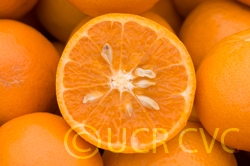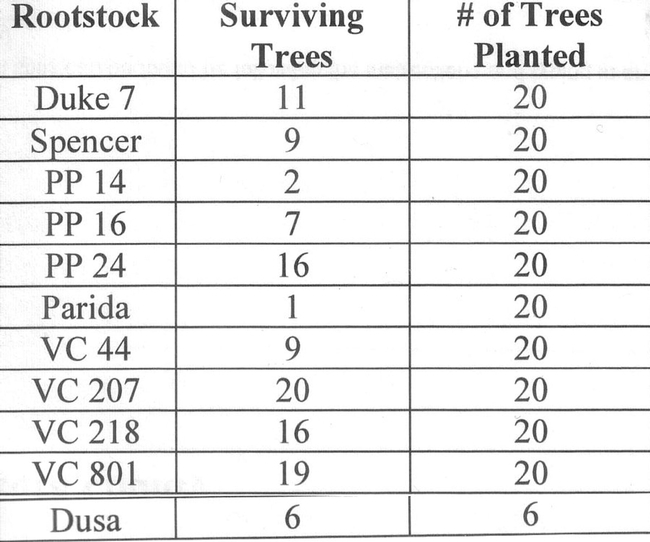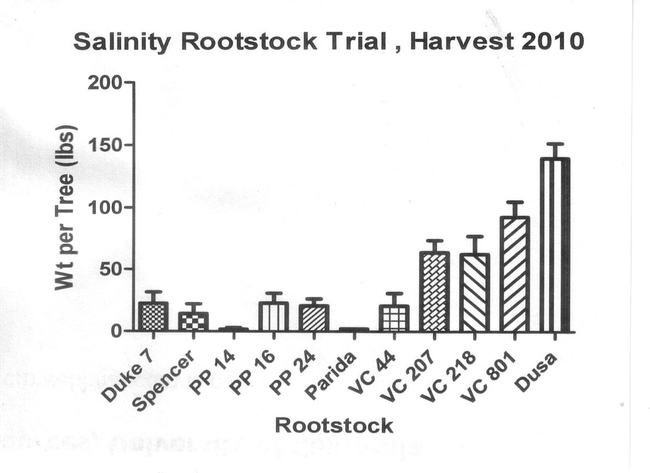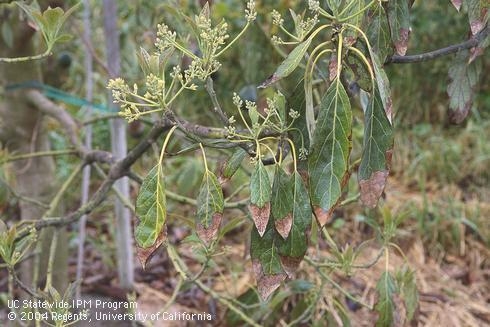
Posts Tagged: tolerance
Some Genetic Resistance/Tolerance to HLB
Ed Stover and crew at USDA, Fort Pierce in Florida have been studying the response of different scions and rootstocks that have been inoculated with the HLB bacteria. As reported in the Proceedings of the International Citrus Conference (http://www.icc2016.com/images/icc2016/downloads/Abstract_Book_ICC_2016.pdf), they have found some scion/rootstock combinations more tolerant or less susceptible to the disease six years after they have been inoculated. It turns out scions with a citron pedigree have more resistance. Also those with a Poncirus (trifoliate) background also had lower populations of the bacterium.
What this means is that there is resistance and possible immunity out there and there is breeding/genetic engineering material out there that can be used to improve the whole of the citrus family to HLB. Of course, this will take time, but there is hope.
Photos:
HLB symptoms and trifoliate leaves

HLB symptoms

trifoliate
Cold Tolerant Avocado Varieties?
Avocado is a fruit tree that is notable for its sensitivity to cold. There are tropical varieities that are very sensitive to cold most notably many of the varieties that are of a West Indian origin. The subtropical varieites that are grown in California are of Mexican and Guatemalan origin or hybrids of these two subraces. ‘Hass' is a variety that has genetic origins of both of these subraces. Mexican origin typically have more cold tolerance than Guatemalan sources. Mexicans can often sustain cold down to the mid-20 deg F for a few hours when trees are mature. Young trees can sustain short periods under 30 deg but can be severely damaged or killed for prolonged times (more than 2 hours). Temperature and duration are not the only factors for determining damage potential. Humidity, wind and surrounding environments (proximity to open water, enclosed areas with reflective heat, etc.) are also important factors.
We know from experience that some varieites of Mexican origin are more cold tolerant than other varieites, some being able to the very low 20's for prolonged periods are survive. They may not produce fruit the following year because all the fruiting wood may be killed, but they will still come back. Varieties like ‘Bacon, ‘Zutano', ‘Stewart', ‘Susan' and even ‘Fuerte' are notable for their greater cold tolerance than ‘Hass'. They may not have the same eating and shipping qualities as ‘Hass' so they will not be commercialized on the scale that ‘Hass' has. But some people like these lower oil content fruit.
It recently came to my attention that there are some low chill avocado varieties that were selected in Texas where winter temperatures are usually killing for most of the avocado varieites we have have. Texas has a much smaller acreage of avocados than California and even Hawaii. So small (under 500 acres) that yields are not recorded for this crop. Most of the trees are backyard trees that have much more protected environments than a normal orchard setting. No really systematic data has been collected on their cold tolerance, but word-of-mouth has identified several varieties that might be cold tolerant. These are ‘Holland', 'Wilma', ‘Joey, ‘Fantastic', ‘Lila' and ‘Poncho'. They may not be the best tasting (that is in the opinion of the taster, as always), the best shipping (thin skinned and damage easily), or hang on the tree for a long period of time, but may make for a good backyard tree in colder environments. There has been no systematic study to determine if and which of these varieties might be more cold tolerant that those that we already are growing in California. Desperate gardeners might find them worth growing in marginal environments.
The avocado as an evergreen subtropical will never likely be a commercial tree in Canada (greenhouses?) but there may be more cold tolerance in the species than we normally associate with the crop. For a description of some of the characteristics of the Texas industry see the bulletin: http://aggie-horticulture.tamu.edu/fruit-nut/files/2015/04/avocados_2015.pdf .

brogdon avocado
Hope for Citrus and HLB?
Recently, I read an article in "Fresh Plaza" about the arrival of large amounts of 'Kinnow' mandarin fruit from Pakistan. http://www.freshplaza.com/article/117470/Discover-Pakistani-kinnow-mandarins-at-Fruit-Logistica-2014#SlideFrame_1
This is a country that is surrounded by countries with huanglongbing. It's also the country where Mark Hoddle, Biocontrol Specialist from UC Riverside, collected Tamarixia radiata , the tiny wasp that is helping control Asian Citrus Psyllid. Pakistan has invested heavily in juice plants just for this industry which was established with this selection that came out of the Citrus Research Station breeding program in the 1930's. It makes me wonder if there might be a significant tolerance to this citrus disease in this mandarin variety. There has been a lot of work by both USDA and U. of Florida evaluating citrus varieties for tolerance to HLB. A wide range of tolerances have been noted. Fred Gmitter along with others are involved with this work and find that under different climatic conditions, resistance can vary. In the 'Kinnow' variety, it looks like there is hope in finding a variety that can be used to breed tolerance into other varieties. The fruit itself is noted for its juiciness and sweetness. But as you can see from the photo, it's got a lot of seeds.

Kinnow mandrain
The Search for Salinity Tolerance in Avocado ; An Update on a Frozen Rootstock Trial
This is the story of a remarkable avocado rootstock trial that was set up in 2004, lost to the freeze of January 2007, recovered (mostly) and had its first harvest in spring of 2010. But the real story is how some of the rootstocks bore at a really high rate with water that was so saline that almost killed most of our California rootstocks.
As part of Crowley and Arpaia's salinity rootstock trial, in cooperation with farm advisors and several growers, and funded by the California Avocado Commission, this particular trial was planted in 2004 at the Nick Stehly Ranch in Valley Center. The trial had 10 different rootstocks all grafted with Hass scions. Twenty trees of each rootstock were planted in a randomized and replicated block design: the rootstocks were Duke 7, Spencer, Parida, VC 44, VC 207,VC 801, VC 218, PP14 (Uzi), PP 16 (Rio Frio) and PP24 (Steddom). The VC series are rootstocks selected in Israel for tolerance to salinity, and the PP series are rootstocks selected for root rot tolerance by Dr. John Menge at the Plant Pathology Dept., U.C. Riverside. At the time of planting it was not known how the PP trees would react to salinity.
In Spring 2005 we planted six Hass/Dusa trees into vacant spots in the trial. These trees were left over from a Bender irrigation trial on another part of the ranch.
The trees were grown with highly saline irrigation water with an average EC of 2.5 and chloride levels of approximately 300 ppm. Needless to say, most of these trees suffered greatly with severe tip-burn and some of the trees almost died. But some looked better than others and we were waiting for the first harvest. In Spring 2006 some the trees set fruit and we expected the first harvest to be in 2007. But then disaster struck!
In January 2007 we had a serious freeze in San Diego County. Nick Stehly called us to let us know that he recorded a temperature of 18° F in our plot. All of the trees looked like they had died and we gave up on this plot and went on to other trials.
But the irrigators didn't give up! They kept pruning the dead wood out of the trees that did not die and gradually brought most of the trees back to life. But the trees were still being irrigated with the saline water, except for one important difference.
The Stehly family liked to swim in the reservoir about three times during each summer. So they would fill the small reservoir at the end of the ranch that supplied our trial, with Metropolitan Water District water with an EC of 0.7 – 0.9. After swimming they used this water for an irrigation of the trial. Amazingly, this “leaching” irrigation was apparently enough to keep the trees growing without too much tip-burn, and the irrigator reported to Nick in January, 2010 that we had enough fruit for a harvest.
The first harvest was completed in March,2010. The data for mean pounds of fruit per tree is presented in Figure 1. The number of surviving trees after the freeze of 2007 is presented in Table 1.


The mean wt of Hass avocados for the VC 801 rootstock was 92.2 lbs, and the mean wt for the Dusa rootstock was 139 lb. If this is compared to the San Diego County average yield of 7000 lbs per acre (about 70 lbs per tree), it would indicate that we might be making progress in finding some better rootstocks for use with some of our saline irrigation waters. However, as we all know, you can't base any conclusions on one year of yield data. We need to have at least three years of yield data to even begin to make a conclusion.
Our hats off to the irrigators at the Stehly Ranch, and to the Stehly family for their cooperation (and their reservoir/swimming pool). You never know what might show up in some of these older rootstock trials.

